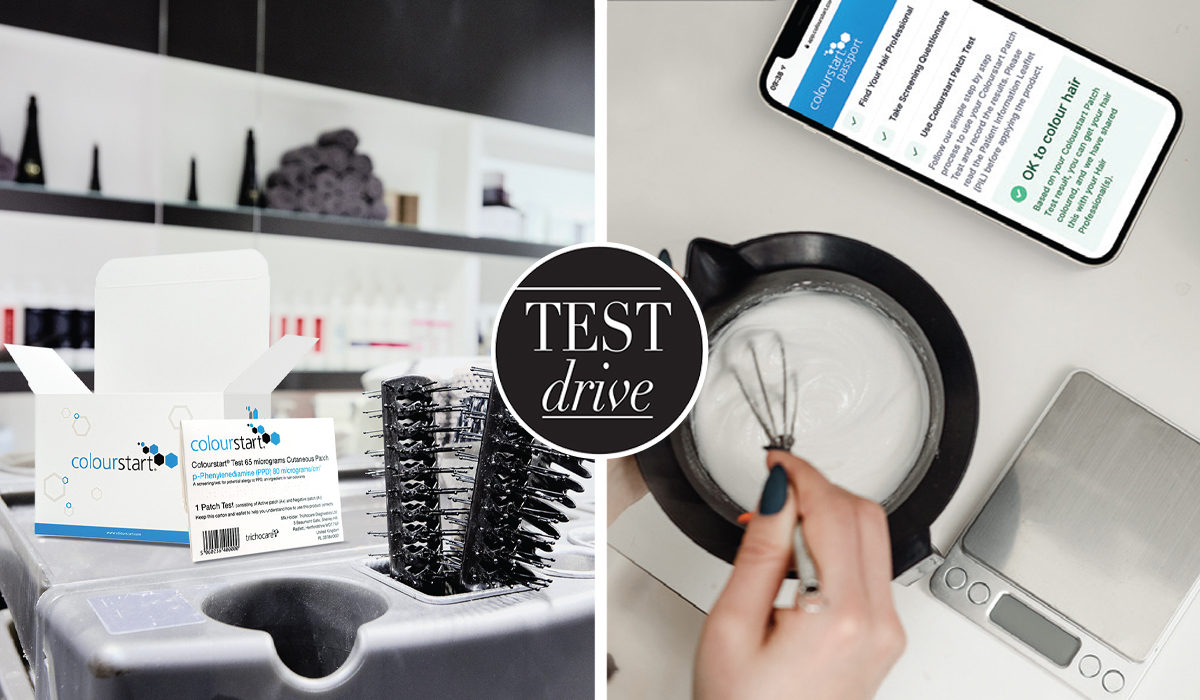Just in case you missed our informative series on the crucial topic of skin testing with Colourstart, here’s your chance to read it again…
In the part one of the series, we look at the crucial topic of skin testing.
The wonderful creative process of colouring comes with a duty of care and level of responsibility that can easily be overlooked.
Skin testing your client before colouring is nothing new. The horror headlines have been captured in the national press for decades, and in the most extreme cases an allergic reaction to colour has resulted in death. So given the risk involved, taking short cuts in skin testing is simply not worth it.
DON’T THINK “IT’LL NEVER HAPPEN TO ME”
Because it does. Let’s be honest, hair colour is a chemical that needs to be used correctly, and that means skin testing every client to ensure they won’t react in an adverse way. According to recent data published from skin test experts Colourstart*, 0.7% of UK salon clients who did not already know they were allergic to hair colour reported a reaction when tested.
TAKE CONTROL OF YOUR BUSINESS
Debbie Digby, Founder & CEO of Passion4hair believes there is major industry wide confusion over skin testing. “A client having an allergic reaction is one of a salon owners’ biggest fears. Risks can come out of the blue. There is major industry wide confusion about it all. Manufacturers say one thing, insurance companies say another, and it can be incredibly confusing.
“Many hairdressers mistakenly think that their colour manufacturer decides how they should skin test, and this is simply not true in many instances. You have control over how you run your business, but you need to make sure what is best for you and your client is insured”.
STANDARDISE HOW YOU TEST AND KEEP RECORDS.
Nick Plunkett is the CEO of leading skin test company, Colourstart. “If there’s one piece of advice I could offer salons, it is to educate your team on a clear standardised policy that’s easy for your staff and your clients to understand, then follow it,” he says.
WORK WITH YOUR INSURER
Adam Haste is the Associate Director for Sentio Insurance Brokers and recommends you should be direct with your insurer about which skin test you plan to use.
1. Manufacturers’ instructions.
In most cases this requires the client to visit the salon for a patch test 48 hours before each and every treatment. This only covers you for use the specific colours that have been tested.
2. Colour house protocols.
This is different to the manufacturer’s guidelines as often the colour house is simply the brand selling the colour, and not the manufacturer. Some colour houses include a protocol consisting of a consultation with specific questions and a patch test only being required every 6 to 12 months, but some colour houses have no protocol at all.
3. The Patch Test Kit.
This is a kit that allows hairdressers to fill syringes with the exact colour they will be using, to post to clients to test on themselves. Clients brings their signed declaration to their appointment. Salons should inform their insurer and colour supplier that you will be using the product before sending it out.
4. Colourstart.
This is a universal test that clients need to potentially use only once. This means you can be flexible with your clients on what colour you might like to use if the client changes their mind on the brand or shade – it’s no problem. Colourstart is the first clinically proven test for allergy to hair colour (PPD) to be licenced by the Medicines and Healthcare products Regulatory Agency (MHRA) and Clients record the whole process using the free, fully auditable Colourstart Passport App. They control this record and can take it with them to any participating salon. It also comes with its own Colourstart Vendors Extension insurance, so regardless of your policy, in the event of an allergic reaction, you’re fully covered.
*Published in the official journal of the European Society of Contact Dermatitis (ESCD) 2022
In part two of our skin testing special, we’re taking a closer look at one salon that has successfully implemented Colourstart skin testing into its colour business.
We spoke to SCOTT BANKS salon in Wakefield about how he’s charging £15 a time for a skin test with no resistance from clients, and why he has never looked back.
PH: Tell us about your salon and its ethos.
Scott Banks (SB): We are located in a Grade II listed building on a pedestrianised section of the Bull Ring, the city of Wakefield’s traditional commercial heart. I started helping in a local salon when I was 13, then went to college, worked, went back to college, and have now been running my own business for over 20 years. The business is the perfect size for me to manage whilst providing very professional, luxuriously unique colour and cutting services. My mantra is this: One – know your clients. Two – focus on doing what you love.
PH: What percentage of your clientele are colour appointments?
SB: Around half of our clients each week are colour appointments. We know every client wants to feel special when they’re with us. So we offer them a superior service, day-in day-out. It’s a bit of an obsession with me. As a result, we have a great client retention rate – it’s all down to the personal touch.
PH: Why did you choose Colourstart to patch test your colour clients?
SB: I decided to embrace Colourstart just before lockdown ended. Like all salons, I was faced with a complex challenge: reconstructing my appointments book, meeting all clients’ colour needing and, at the same time, ensuring I was meeting all the ‘testing before colour’ protocols. It was a completely unrealistic situation and, frankly, I was really worried. Then I heard about Colourstart on social media, and I thought this could be the solution, especially when I saw they have their own insurance. It had to be worth trying.
PH: Was it challenging to implement this into your business?
SB: No. It started with a Zoom meeting to talk through the system, we then contacted all our existing clients to explain to them how the new testing system works. It was amazing, so many of our clients were desperate to book their colour appointments straight away after lockdown and Colourstart meant we had one less thing to worry about.
PH: At what stage do you introduce new clients to this way of testing?
SB: New colour clients are given a pre-appointment face-to-face consultation, and that’s when they too are given the opportunity to sign up for their Colourstart Passport. We help clients set their Passport up and show them how to use the patch test. And the Colourstart app is a great help too. We make it very clear to everyone: our policy is ‘No skin test, no colour’.
PH: Is the £15 charge for the test a hurdle?
SB: The fact that clients are asked to pay for their Colourstart patch test has not been an issue. Our clients trust us, and understand that the decisions we make help to ensure their well-being, enhance our quality of service, and enable us to deliver exactly what they require. That can mean frequent changes of tint and last minute decisions about colour choices. Colourstart enables us to be super responsive and versatile and our clients really appreciate that. Also, this is a one-off test and clients don’t need to repeat it unless there’s a reason to.
PH: How have the team found this method of testing compared to traditional blob testing?
SB: It is definitely less hassle for the team. Previously, using the manufacturer’s AAT was a big time commitment for us, and resulted in wasted tint as well. We were constantly having to remind clients to test ahead of their appointment, and even turning clients away who had forgotten to test. Now the responsibility is shifted to the client, and we can monitor their Passport to check all is well.
PH: Ultimately is testing this way having a positive impact on your business?
SB: It shows our clients we really care about them. In these times when allergies seem to be increasing and we’re all more aware of being safe and healthy, it’s reassuring for our clients to know we’re looking after them. All good salons want to win and keep the trust and confidence of their clients. And Colourstart is helping us do just that.





